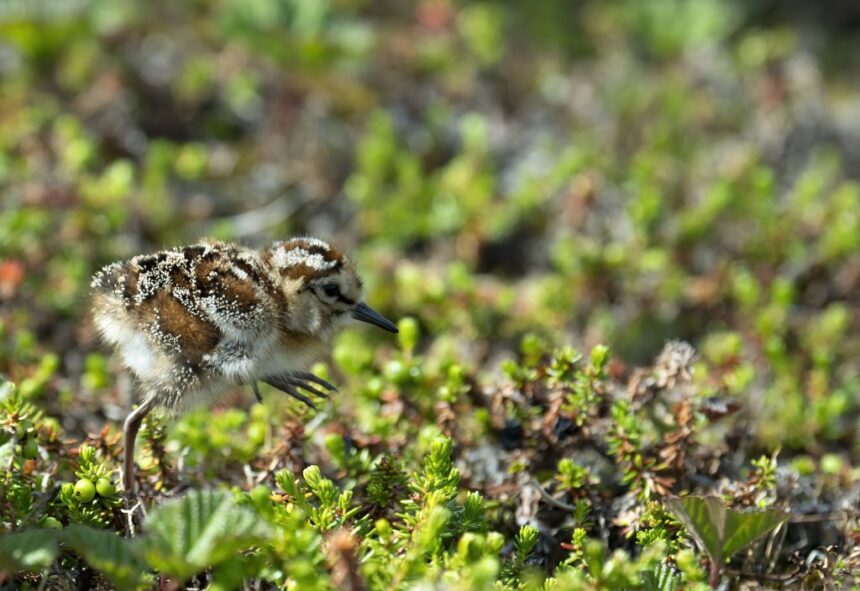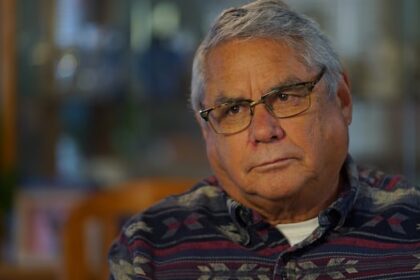A proposed expansion at Canada’s busiest port could be fast-tracked by the federal government. The impact could be felt by many species, including a tiny but mighty bird and its source of superfood that’s uniquely plentiful in the Fraser estuary of Metro Vancouver. Microscopic organisms make up the food — called biofilm — which supports the round, fluffy western sandpiper. Biofilm provides the little shorebird fuel as it makes an epic journey between Peru and Alaska. Thousands of western sandpipers fly in artistic murmurations and gently poke their pointy beaks into the mud, scooping up biofilm with hairy tongues. Biofilm is part of the foundation of the food chain that also supports crabs and fish, bears and whales. But Roberts Bank Terminal 2, the expansion at Canada’s biggest container terminal Deltaport, is on the path to double in size. The goal is to bring in larger cargo ships and even more imported items from overseas — a development many scientists conclude will weaken the Fraser estuary’s ability to be a refuge for wildlife. Tiny western sandpiper relies on biofilm, which is high in fatty acids, to power them in their epic journey from as far as Peru to Alaska. The birds typically weigh between 22 and 35 grams, about the same as a piece of bread. The 2020 federal assessment of the project concluded the expansion’s impact on wetland function, Chinook and chum salmon and southern resident killer whales “is high in magnitude, permanent and irreversible.” The review panel concluded it could not say with certainty how the expansion may disrupt biofilm and western sandpipers since it’s a new area of research — but acknowledged there is no known way to recreate the habitat. Biofilm, a naturally occurring phenomenon, has not been successfully re-engineered by humans in all its natural complexity. The provincial assessment also concluded the expansion would have negative effects, and federal and provincial environment ministers agreed with the conclusions. But Canada approved the project anyway in 2023 — arguing it is in the “national interest” — subject to 370 environmental conditions. B.C. ministers cited environmental concerns, but said the province does not have jurisdictional power to stop the project. Now, in the face of escalating trade tensions with the United States, both British Columbia and Canada are looking to expedite major industrial projects, raising concerns from environmental organizations and First Nations that environmental considerations may be pushed to the wayside. Roberts Bank Terminal 2 was on a draft list of 32 projects to potentially fast-track under the Building Canada Act, according to an internal government document obtained by the Globe and Mail. “They’re cute and they’re small,” Bob Elner said about western sandpipers. They have hairy tongues and long, flexible beaks. They bob their heads a bit when they walk and weigh less than a golf ball. ‘The science is being ignored’ Biofilm is made up of diatoms — microscopic organisms a fraction of a hair’s width wide. It’s a widespread phenomenon, but at the Fraser estuary, the biofilm is very “activated” and “rich” compared to nearby estuaries, Elner explained. Bob Elner, scientist emeritus with Environment and Climate Change Canada and adjunct professor at Simon Fraser University, said evidence suggests this unique richness is due to the spring influx of fresh water from the Fraser River into the salt water, which causes a “shock” in the tiny diatoms, causing them to be highly active and pulse out rich omega-3 fatty acids and other nutrients. Elner said Roberts Bank “is the largest old unaltered, intertidal estuary” in the province; equivalent banks have been impacted by development. He closely studies western sandpipers, but said they aren’t the only creatures that may decline as a result of changing the biofilm. “Really, it’s much bigger than that, because those same fatty acids [in the biofilm] are responsible for the eulachan fishery, salmon fisheries and it goes up to orcas and marine mammals. It’s really that transfer of fat — these fatty acids — through the system,” he explained. Western sandpipers in front of Deltaport in Tsawwassen. The shorebirds rely on Roberts Bank in the Fraser estuary as a place to rest and refuel with high-fat biofilm. The Vancouver Fraser Port Authority, the federal agency that pitched the project, touts the economic payoff of expanding the cargo terminal and argues more cargo capacity is needed. But Elner emphasized the estuary is a “high-value” system that could be “fundamentally, ecologically destroyed.” “This isn’t that ports are bad,” he said. “Biofilm is really valuable, and we’ve got options in terms of how we get containers from wherever back to wherever, so trade doesn’t trump the environment.” “I believe in science,” he added. “The science has been ignored.” There are only 73 endangered southern resident killer whales left, according to most recent data. Marine traffic noise disrupts their ability to hunt and communicate with sonar, and the port is expected to impact Chinook salmon, which the whales rely on. Between Peru and Alaska, every western sandpiper will likely stop in the Fraser estuary Deltaport connects the West Coast to the world of international trade. Clothing, electronics and manufacturing parts are packed in the thousands of cargo containers that pass through the port every day — more than all five other ports in Canada combined. Roberts Bank is a significant stop on the Pacific Flyway shorebird migration route. It’s widely assumed every western sandpiper will stop at Roberts Bank at least once in its lifetime, Elner said, between breeding in Alaska and wintering down south. You can go down to Roberts Bank and watch the birds roll in and out with the tide as they go north in spring and south in late summer. “It’s quite magnificent to see them flying in these huge flocks,” he said. Western sandpipers’ next major stop in their spring migration is in the Stikine estuary, about 1,000 kilometres northwest. The tiny birds are far less likely to survive the journey without the bountiful biofilm at Roberts Bank, Elner explained. “Every year, less and less birds will make it to the Arctic. There will be less numbers successfully breeding. We can interpret that in a fairly short number of generations, we’ll be looking at a species that’s a vestige of what it once was,” he explained. A murmuration of western sandpipers fly over the water near Roberts Bank. It’s hard to count migrating birds, but estimates sit around 2.8 to 4.3 million. Shorebirds are declining significantly worldwide. “The risk this will occur is very, very high, and the outcome is very predictable — species-wide impact, but also impacts at the fisheries level.” Shorebirds are one of the “fastest declining groups” of birds in the world, he added. “Much of it, in my professional opinion, is tied to the removal of these sources of active biofilm.” The Fraser River estuary has already lost 85 per cent of its salmon habitat, and the proposed project would deplete an additional 177 hectares. A 2022 study found 102 species in the Fraser estuary are at risk of local extinction between now and 2045. Federally mandated biofilm research at Roberts Bank must remain rigorous if project fast-tracked: scientist The federal conditions include convening an arm’s-length panel of scientists to oversee research and monitoring of biofilm and shorebirds up until construction begins. If it’s determined the ecosystem is being compromised, the port could be required to remove the structure, redesign it or mitigate it. Elner believes it’s a “credible” process that could effectively identify risk and require a dramatic correction to reduce that risk. But as Roberts Bank Terminal 2 is on a preliminary list of candidates to be fast-tracked, Elner emphasized environmental processes need to remain rigorous. The Port of Vancouver sees $275 billion of trade pass through every year, exporting goods like pulp, lumber, coal and crops. The port includes other sectors, like automobiles and bulk goods, but the expansion only affects the container terminal. Bob Elner turns over some mud at Roberts Bank. The mud is not obviously full of life, but is in fact home to highly active biofilm made up of algae and bacteria. The Vancouver Fraser Port Authority says its forecasts show more container capacity is needed, and the expansion meets the projected demand. The project would widen the rail causeway leading to the port and build an artificial island about the size of 330 football fields to house three new berths, increasing container capacity on the West Coast by about 30 per cent. It would increase the port’s container capacity by nearly 50 per cent, meaning it could handle an additional 2.4 million 20-foot shipping containers each year. The port authority anticipates construction will begin in 2027 and the terminal will take about six years to build, becoming operational in the early- to mid-2030s. It projects the terminal will add $3 billion to the economy every year. The Narwhal asked the port authority whether the original $3.5-billion price tag to build the terminal has changed due to economic factors and inflation, but the port authority said that was confidential as it tries to procure a construction partner. Western sandpipers eat at Roberts Bank near Deltaport. Estuary habitat is biologically rich, and the Fraser estuary is a biodiversity hotspot. But estuaries are also highly desirable for development. Port authority says environmental conditions will be met, but independent scientists say they need more information about how The Vancouver Fraser Port Authority declined to be interviewed by The Narwhal and instead sent an emailed statement in response to questions. It said it is on track to meet the hundreds of environmental conditions from the federal and provincial government. The total sandpiper population is estimated at 3.5 million birds, and it’s likely all of them will stop at Roberts Bank at some point. The port authority said “studies show even with the project in place, there will be sufficient biofilm to support one million sandpipers in a single day.” It did not provide specific studies in its statement or after The Narwhal asked for such evidence, but referred us to hundreds of pages of documents. In them, we could only find the port authority referencing its own models to make this prediction. The port authority said it does not expect any impacts on sandpipers, but will “avoid, monitor and — if required — mitigate any potential effects.” But scientists have reaffirmed multiple times they cannot confidently conclude negative effects will not impact biofilm or migratory shorebirds. In 2022, Environment and Climate Change Canada said the project “will likely be unmitigable and irreversible,” leading to higher risk to the “viability” of western sandpipers and have “major” effects on the quality of biofilm. A sandpiper helps itself to biofilm at Roberts Bank. The port authority has often said the federal review panel found the project would not result in adverse effects on biofilm in its 2019 report. But in 2022, Environment and Climate Change Canada called this an “incomplete” description by the port authority, explaining there is “uncertainty” since science around biofilm is quite new, and emphasizing this means the review panel could not say the expansion would not have negative impacts either. The independent scientific body that has been overseeing the port authority’s monitoring of biofilm and sandpipers — mandated as part of the 370 federal conditions to approve this project — underlined this uncertainty in its most recent report earlier this year. The group of independent scientists called for more details about how the port authority plans to execute its monitoring or analyze the data it collects. They outlined the challenge of using local data to make any assumptions about changes to the entire population, and said it’s unclear how the port authority will make this connection. It said “more precision” is needed in the plans or else they risk producing “erroneous” results. The group of scientists wanted to see more evidence from the port showing its methods will produce reliable information. Specifically, they said the port may need to extend how long it monitors the birds. Right now, the port wants to monitor for three years after the proposed terminal is built, but the scientists pointed out that any decline would likely result from fewer birds reproducing year over year, so population decline may not be detectable until more than three years later. A coyote trots among the many western sandpipers, with Deltaport visible in the background. The scientists pointed out some of the port’s proposed monitoring would only detect if there was a 50 per cent change in population or higher over two years, and any change under 50 per cent would not be detected. “Changes considerably smaller than 50 per cent may be biologically significant, especially if they occurred over such a short time interval,” the scientists pointed out. Additionally, counting western sandpipers is difficult, and there’s potential for the port’s plans to result in incorrect counts, scientists added, which may under- or over-estimate the impacts on birds. The port authority told The Narwhal the western sandpiper population is trending upwards, and only 17 per cent relies on Roberts Bank during spring migration. The Narwhal found other scientific sources that suggest western sandpipers could be declining, and up to 64 per cent of the population relies on Roberts Bank. The Vancouver Fraser Port Authority is confident enough biofilm will remain after the expansion to feed one million shorebirds in a single day. The expansion was originally estimated to cost $3.5 billion. The Narwhal asked if there is an updated figure, due to inflation and other economic factors, but the port authority said the cost estimate is “confidential” as it tries to procure a construction team. The port authority has signed 27 mutual benefits agreements with the 28 Indigenous governments it is seeking agreements with. Prime Minister Mark Carney announced the launch of the Major Projects Office in August, with the goal to “fast-track nation-building projects by streamlining regulatory assessment and approvals and helping to structure financing.” The office said it will help the proponents finish the final regulatory steps and information will be shared online the same as it typically is, and no research or monitoring timelines have been condensed. Fast-tracking will come from “upfront certainty regarding approvals” and some processes happening simultaneously rather than sequentially, it added. “While we are moving forward on projects that will build Canada … we are equally committed to upholding Canada’s environmental protections.”
Tiny birds, and their tiny superfood, could decline due to irreversible effects of Vancouver port expansion











